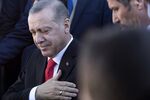Erdogan Was a Target in Bribery Inquiry, Turkish Officer Says
By-
Officer says now-president was ‘No. 1’ figure among suspects
-
Jury sees surveillance photos of Zarrab, bribery courier

Recep Tayyip Erdogan
Photographer: Konstantinos Tsakalidis/BloombergTurkish president Recep Tayyip Erdogan was among the targets of a bribery and money laundering investigation in that country related to illicit flows of Iranian oil proceeds, a former Istanbul police officer testified in New York federal court.
Huseyin Korkmaz said the investigation initially focused on the organization run by gold trader Reza Zarrab, but later grew to include dozens of others. He called Erdogan the "No. 1" target in a group that also included Mehmet Zafer Caglayan, the former economy minister, and Suleyman Aslan, ex-chief executive of Turkiye Bank Halkasi AS, a large Turkish state-owned bank, which was central to the scheme.
The laundering conspiracy had the effect of "making Mr. Zarrab into a cartel," Korkmaz said Monday.
The testimony of Korkmaz, who was the head of the team that conducted the investigation, confirms for the first time that the corruption case in Turkey was aimed directly at Erdogan -- not just ministers, associates and family members. It may go some way toward explaining why Erdogan responded so forcefully to it, as well as the Turkish government’s response to the probe being re-opened in the U.S.
The Turkish investigation was ended after the arrest of Zarrab in December 2013 and a raid on the home of Aslan, which recovered millions of dollars in cash stuffed into shoe boxes. Photos of the cash recovered from the raid were shown to the jury. The photos were taken in the course of the Turkish investigation. Erdogan was prime minister at the time.
Halkbank’s Atilla Reassured Treasury as Plot Went On, U.S. Says
As the U.S. ratcheted up financial sanctions on Iran in retaliation for its effort to become a nuclear power, Iran was increasingly unable to access billions of dollars piling up in overseas banks as a result of oil sales to foreign countries. Prosecutors allege Zarrab, with the aid of Turkish officials and bank executives, ran a laundering scheme to get around the sanctions and use Iran’s money to make international payments on its behalf, including $1 billion that flowed through banks in New York.
Zarrab pleaded guilty in the weeks before the trial and spent seven days on the witness stand detailing the plot. He testified against Halkbank executive Mehmet Hakan Atilla, now the lone defendant in the case. Nine people were charged in the U.S. case, including Aslan and Caglayan, but the other defendants have avoided U.S. arrest. Erdogan wasn’t charged in the case.
Last week, Zarrab testified that Turkey’s prime minister personally ordered the resumption of the plot to launder billions of dollars in Iranian oil revenue and circumvent U.S. sanctions in 2014 after an investigation into the matter was quashed. Zarrab didn’t name Erdogan in this portion of his testimony, although he appeared to be referring to him. Erdogan occupied the official until late August 2014, when he became president.
Zarrab also testified that a senior Turkish official said to him that Erdogan personally approved a plan to involve two Turkish banks in the scheme.
Turkish Leader Restarted Iran Laundering Plot, Witness Says
Defense lawyers for Atilla have told the judge they plan to request a mistrial, saying the evidence and testimony isn’t relevant to Atilla and that U.S. prosecutors have failed to fully explain how they obtained it.
Prosecutors’ questioning of Korkmaz is intended to show the jury how the investigation came to be shut down. Prosecutors showed the jury more surveillance photographs in which Korkmaz said bribery payments were being made. They included one depicting a man identified as Zarrab’s bribery courier outside the office of a charitable foundation founded by Erdogan.
The laundering scheme first employed gold trading as a means of getting Iran’s money out of Halkbank, then turned to disguising the flows as humanitarian food shipments after revised sanctions rules banned the gold trade. The photo of the courier outside the charitable foundation, taken July 7, 2013, was taken around the same time Zarrab was recorded in a wiretapped conversation discussing efforts to revive the gold trade, Korkmaz testified.
Under questioning by Assistant U.S. Attorney Michael Lockard, Korkmaz -- boyish, bespectacled and wearing a button-down sweater under his suit -- testified that Atilla was among the Halkbank executives who were under investigation in the Turkish case. But he said he wasn’t aware of any evidence that Atilla was among the people who received bribes from Zarrab.
Other photos from the Turkish investigation shown to the jury included one of Zarrab’s courier stopped at Istanbul’s Ataturk airport with bundles of cash in a bag on the way to see the economy minister and one of Zarrab arriving at the office of Turkey’s European Union ministry. Another was of two men outside Zarrab’s office, picking up what Korkmaz said was $200,000 in bribe money for the head of the interior ministry, which controls the police force.
The case is U.S. v. Atilla, 15-cr-867, U.S. District Court, Southern District of New York (Manhattan).
— With assistance by Bob Van Voris